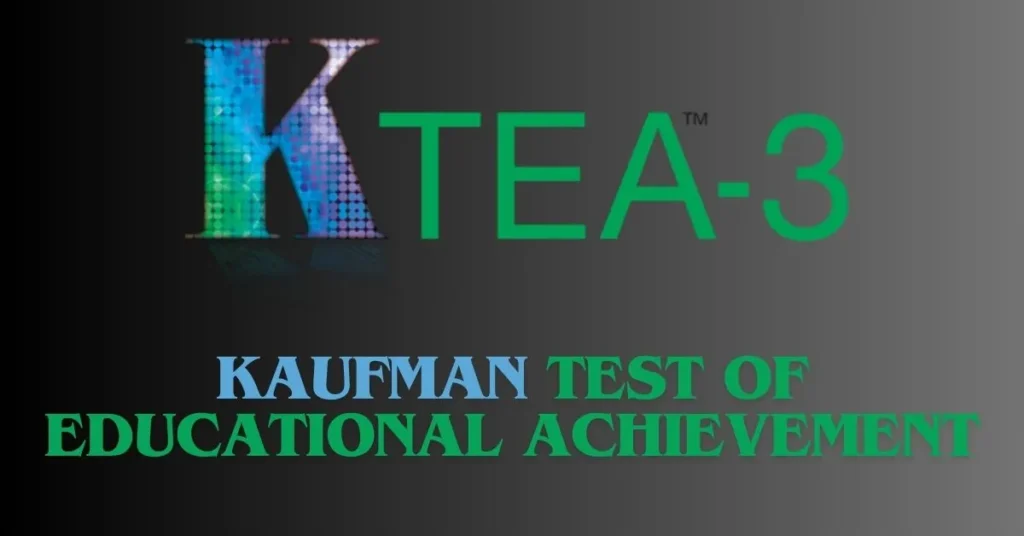In the world of educational assessments, various tools help educators understand students’ academic strengths and weaknesses. One such tool, the Kaufman Test of Educational Achievement (KTEA), stands out for its comprehensive evaluation of students’ academic abilities. Whether you’re a parent, teacher, or education professional, understanding the KTEA can provide valuable insights into student learning and progress.
What is the Kaufman Test of Educational Achievement?
The Kaufman Test of Educational Achievement is a standardized test designed to measure academic skills in children and young adults, from kindergarten through 12th grade. Developed by Dr. Alan S. Kaufman and Nadeen L. Kaufman, this test assesses a wide range of skills, including reading, math, written language, and oral language. It’s used by schools and psychologists to identify learning disabilities, plan educational interventions, and track student progress over time.
What makes the KTEA particularly useful is its versatility. It can be administered individually or in groups, making it adaptable to various educational settings. Additionally, the KTEA offers different forms—Comprehensive, Brief, and Normative Update—allowing for flexibility based on the specific needs of the assessment.
The Structure of the KTEA:
Understanding the structure of the Kaufman Test of Educational Achievement helps in appreciating its thoroughness. The test is divided into several subtests, each targeting specific academic skills. For example, the reading subtests include Letter & Word Recognition, Reading Comprehension, and Decoding. In math, students might be assessed on Math Concepts & Applications and Math Computation.
These subtests are designed to provide a detailed picture of a student’s abilities. By breaking down academic skills into specific components, the KTEA allows educators to pinpoint areas of strength and weakness accurately. This detailed information is crucial for developing targeted educational plans and interventions.
Why Use the KTEA?
The Kaufman Test of Educational Achievement is a valuable tool for several reasons. Firstly, it provides a comprehensive assessment of a student’s academic abilities, covering a broad spectrum of skills. This comprehensive approach ensures that no aspect of a student’s learning is overlooked.
Secondly, the KTEA is known for its reliability and validity. The test has undergone rigorous testing and development to ensure that it accurately measures what it intends to measure. This reliability makes it a trusted tool for educators and psychologists alike.
Moreover, the KTEA is user-friendly. The instructions are clear, and the test can be administered in a relatively short amount of time. This ease of use means that students and educators can focus on the assessment without being bogged down by complicated procedures.
Administering the KTEA:
Administering the Kaufman Test of Educational Achievement requires proper training to ensure accurate results. Typically, trained professionals such as school psychologists or special education teachers administer the test. The process involves following standardized instructions to maintain consistency and reliability.
Before administering the test, it’s essential to establish a comfortable environment for the student. Reducing anxiety and providing a distraction-free setting can help the student perform to the best of their abilities. During the test, the administrator should provide clear instructions and support, ensuring the student understands each task.
Interpreting KTEA Results:
Once the Kaufman Test of Educational Achievement is administered, the results need to be interpreted accurately. The KTEA provides scores for each subtest, which can then be compared to normative data to determine where a student stands in relation to their peers. These scores can highlight specific areas where a student excels or may need additional support.
Interpreting the results also involves looking at patterns across different subtests. For instance, a student might perform well in math but struggle with reading comprehension. Understanding these patterns helps educators tailor interventions and support strategies to meet the student’s unique needs.
Applications of the KTEA:
The Kaufman Test of Educational Achievement has various applications in the educational field. One of its primary uses is identifying learning disabilities. By pinpointing specific areas of difficulty, the KTEA can help diagnose conditions such as dyslexia or dyscalculia. Early identification of these issues is crucial for providing timely and effective support.
Another application is in tracking student progress over time. By administering the KTEA at regular intervals, educators can monitor a student’s development and adjust educational strategies accordingly. This ongoing assessment ensures that interventions remain effective and responsive to the student’s evolving needs.
The KTEA and Individualized Education Programs (IEPs):
For students with special needs, the Kaufman Test of Educational Achievement plays a vital role in developing Individualized Education Programs (IEPs). The detailed assessment provided by the KTEA helps educators and parents create tailored educational plans that address the student’s specific strengths and weaknesses.
IEPs are essential for ensuring that students with disabilities receive the appropriate accommodations and support. The KTEA’s comprehensive evaluation provides the data needed to set realistic goals and measure progress, making it a key component in the IEP process.
Benefits for Teachers and Parents:
The Kaufman Test of Educational Achievement offers numerous benefits for teachers and parents. For teachers, the KTEA provides detailed insights into their students’ academic abilities, allowing them to differentiate instruction and provide targeted support. This can lead to more effective teaching and improved student outcomes.
For parents, the KTEA offers a clear understanding of their child’s academic strengths and challenges. This information is invaluable in advocating for their child’s needs and collaborating with educators to develop effective support strategies. Additionally, parents can use the results to monitor their child’s progress and celebrate their achievements.
The Future of the KTEA:
As education continues to evolve, so does the Kaufman Test of Educational Achievement. Advances in technology and educational research are likely to influence future editions of the KTEA, making it even more effective and user-friendly. These updates will ensure that the KTEA remains a relevant and valuable tool for assessing student achievement.
Moreover, as awareness of diverse learning needs grows, the importance of comprehensive assessments like the KTEA becomes even more critical. Educators and psychologists will continue to rely on the KTEA to provide the insights needed to support all students in their educational journeys.
Conclusion: The Value of the KTEA
The Kaufman Test of Educational Achievement is an indispensable tool in the realm of education. Its comprehensive assessment capabilities, reliability, and versatility make it a valuable resource for educators, psychologists, and parents. By providing detailed insights into students’ academic abilities, the KTEA helps ensure that all students receive the support they need to succeed.
As we look to the future, the role of the KTEA in identifying learning disabilities, tracking progress, and developing individualized education plans will continue to be essential. Understanding and utilizing this powerful assessment tool can make a significant difference in the educational outcomes for countless students.







